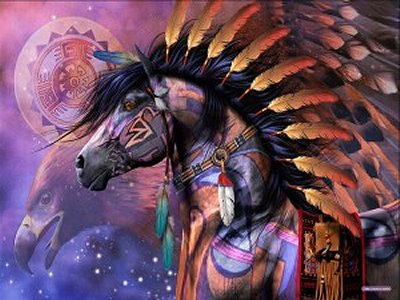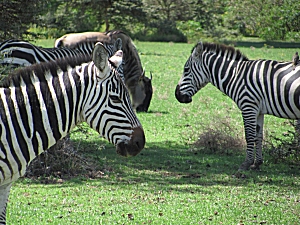 |
SPIRIT
LODGE
LIBRARY
Totem
Animals
Page
197
|
(Main
Links of the site are right at the bottom of the page)
Some of the links for the 197 pages in this Totem Animals section
are below. For the rest please go HERE
ZEBRA
By CinnamonMoon

*Lady Stearn Robinson & Tom Gorbett/The
Dreamer's Dictionary:
If you dreamed of a herd of these striped animals, they are
warning you that your efforts are
being expended in the wrong direction; however, if your dream
featured a tame one, it predicts
gain from an unexpected source.
*Mary Summer Rain/On Dreams:
Zebra represents the good-evil, right-wrong polarity of various
elements in one's life.
*Ted Andrews/Animal-Wise:
Keynote: Agility not strength brings success; individuality
within group settings.
Zebras stand out on the African plains like fish in a glass
bowl. Although they are the lion's main
prey, they flourish because they have adapted.
There are two main types of zebras, plains and mountain, and
they both live in small herds
consisting of a single male and 8-10 females. In herds that
are somewhat permanent, the females
bond and even groom each other. All male groups are formed from
the bachelors, and in both
groups, status is based upon age and how long they have been
in the group. Dominance is
dependent upon agility, not strength.
The striping of the zebra is a form of camouflage. In the herd,
one zebra will not stand out and
the lion or other predator may hesitate a vital second in its
confusion. All zebra patterns are
different, but the only ones to whom it really matters and recognize
them as different are other
zebras.
Often for those to whom the zebra is a totem or messenger, blending
into the crowd will usually
work best in endeavors. There should be no fear of losing one's
identity in the crowd as each one
is truly different. Zebras teach us individuality within group
settings.
Zebras have intricate social behavior, with a great variety
of expressions, which can show us
ways of working and understanding group dynamics and communications
more clearly. They
help us in working in a group more effectively--especially by
various vocal expressions and body
language.
A zebra's major predator is the lion, and thus it should be
studied as well. A few moments
inattention by the zebra is all a lion needs to get within striking
distance. In order to escape, the
zebra must rely on their speed and agility. It is also possible
that the lion may be confused by the
stripe pattern if it runs into the herd.
Zebras seldom fight, but when they do, it is usually in a battle
for the harem at the beginning of
mating season. In cases of attack by a predator, sometimes they
must fight as well. If flight is
truly impossible, a zebra stallion can kick hard enough to knock
out the lion's teeth or even kill
it. But always it tries to rely on its agility and speed first.
This is a reminder for those to whom the zebra is a totem. When
the zebra appears, examine your
relationship to various groups in your life. Do not confront
directly unless there is no other
choice. Use your mental agility to work around problems and
obstacles, especially if it is in the
form of other people and competitors.
Are you losing your identity? Are you not asserting your individuality?
Are you confronting
rather than relying on more indirect methods? Are you trying
to bull your way through obstacles
when agility and subtlety will do?
*Notes from an email about Zebra that Tarra sent me about 5
years ago or so. *Smiles* Thanks
Tarra!
Zebras live in eastern and southern Africa. Zebras are horses
with black and white stripes.
Ancient Roman and Greek sailors brought Zebras back from Africa
almost 2,000 years ago. The
Romans trained zebras for their circuses. The Greeks called
them "horse tigers." Zebras belong
to the horse family or Equidae. This family has horses, zebras,
and donkeys. There are three
different species of zebras--Grevy's, Mountain, and Plains Zebra.
Each species has a different
pattern of stripes.
Grevy's Zebras are the largest. They are about 5' tall at the
shoulder. They have narrow black
stripes, a white belly, and large, rounded ears. They live in
Somalia, Ethiopia, and northern
Kenya. There are two kinds of Mountain Zebras. Cape Mountain
Zebras are the smallest. They
stand only 4' at the shoulder. They have a small flap of skin
called a "dewlap" under their necks.
Hartmann's Zebra is the other Mountain Zebra. It is slightly
larger than the Cape Mountain
Zebra. Less than 5,000 of these animals are alive today. Humans
threatened both species of
Mountain Zebra with extinction. Miles of huans protecting their
livestock limit their migrations.
The Plain Zebra are the most common species. They live in the
grassy plain woodlands and open
plains of East Africa. Plain Zebras stand about 4 1/2' tall
and weigh from 500-600 pounds. They
have broader stripes and larger hooves than Grevy's Zebras.
Most Zebras have black and white
stripes. But some have brown, gray, yellow, red, or buff-colors
stripes. The color depends on the
time of year, the area, and the age of the Zebra. Some species
have stripes farther apart with a
"shadow" stripe in between set close together. Some
Zebras have stripes over their whole body,
down to their hooves. Like the Grevy's Zebra, other species
don't have stripes on their bellies or
down their legs.
The most interesting fact about Zebras' stripes is that no two
animals are exactly alike. Their
stripes are like our fingerprints. Just no two people have the
same fingerprints; no two zebras
have identical stripe pattern. Horses and Zebras are a lot alike.
They eat the same thing, they look
the same (minus the stripes), and they are called the same names.
For example, a female adult is
called a mare. The head male of the heard is the stallion; a
baby horse is called a foal. Both
Zebras and Horses are called herds when there is more than 6
animals. Some herds are as big as
15,000 to 100,000!
A Zebra can reach up to 37mph. The horse can reach up to 45.
Zebras and Horses have a lot in
common. They also have a lot of differences. Zebras manes grow
straight up from their neck;
horses mane grow downward. A horses tail is long and grows out,
a Zebra have tuft of hair at the
end of its tail. Grevy's Zebras have a longer tail.
Zebras have a good sense of hearing. They can turn their ears
to hear the faintest sounds. Zebras
have really good eyesight. They can see almost anything that
is coming even when they are
bending down eating. The horse family can move both their eyes
in different directions at the
same time. Zebras also have a sharp sense of smell. It is easy
for them to tell what sex they are
and it helps the mother to identify their foals.
The horse family is fast and graceful runners. A hard hoof protects
the middle toe on each foot.
This is called the frog. The horse family has 3 toes on each
hoof; their frog, chestnut, and fetlock.
The chestnut is a toe that is on the inside of its leg. The
fetlock is a tuft of hair above the hoof.
The Zebra has 3 gaits; walk, trot, and canter. Zebras eat mostly
grass and other small plants.
They have low protein in their diet, so they must eat a lot
to get the nutrients they need.
Zebras also need a lot of water. Sometimes they dig holes with
their hooves to find water. Zebras
like to groom each other. They use their teeth and tongue to
clean dirt and insects off their coats.
They use their tails as flyswatters. They also roll in the dust
to protect themselves from the
blazing sun and insects. Small birds called oxpeckers ride on
the Zebra's back and eat insects
under their skins. They also fly by when an enemy comes near.
A foal is usually born in January or February. The stallion
stands near the mare when she is
having birth to protect them from harm. A new born foal weighs
about 60-70 pounds and is
about 3'. Their stripes are brown and tan. The mother licks
the nose, eyes, and ears of their
newborn foal. The foal can stand about 10 minutes after they
are born. It can walk in half an hour
and run in an hour. A foal starts drinking its mothers milk
in an hour after its birth. They can live
on the milk up to 7 months. Usually it starts eating grass.
A foal stays with its mother for about a
year old. Then they can go and start their own family. Unless
they are killed by hunters or
predators. Zebras can live up to 15-20 years.
When a stallion dies, the mares and foals stay together and
another stallion takes over. Zebras are
good fighters. They have special adaptations that help them
survive. Lions, leopards, hyenas,
jackals, and wild dogs are their main enemies. If a Zebra stands
alone, it is easy to see. If the
herds stand together, it is harder to see a single Zebra because
it confuses their enemy. Zebras
escape by running very close together.
Humans are the greatest enemy of the Zebra. Poachers hunt the
animals for their hides and tails.
They often attack at night or at the watering hole. Zebras are
also dying of diseases and parasites.
Anthrax--a fatal disease--infects Zebras. The quagga, the most
beautiful Zebra, died out in 1883.
They lived in southern Africa. Its name came from its barking
call--"kwa-ha." Early colonists
killed quaggas for their meat and hides. They had flowing tails
and brown and white stripes.
Their tails had no stripes. The last quagga died in a zoo in
Europe in 1883. If illegal poaching
continues, the other Zebras will become extinct forever.
By Zebra Girl (Tarra's daughter).
Zebra's medicine is to blend in with the crowd and their surroundings.
They don't like to stand
out and be judged. Zebra medicine is also: Balance, seeing in
black and white, clarity without
filters, power, sureness of path, maintaining the individual
within the herd.
|
Libraries
are on this row
|
|
|
INDEX
Page 3
(Main Section, Medicine Wheel, Native Languages &
Nations, Symbology)
|
|
INDEX
Page 5
(Sacred Feminine & Masculine, Stones & Minerals)
|
|
|
|
|
|
©
Copyright: Cinnamon Moon & River WildFire Moon (Founders.)
2000-date
All rights reserved.
Site
constructed by Dragonfly
Dezignz 1998-date
|
|